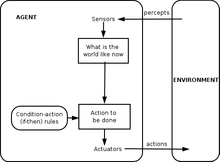| Part of a series on |
| Multi-agent systems |
|---|
| Multi-agent simulation |
| Agent-oriented programming |
| Related |


A multi-agent system (MAS or "self-organized system") is a computerized system composed of multiple interacting intelligent agents.[1] Multi-agent systems can solve problems that are difficult or impossible for an individual agent or a monolithic system to solve.[2] Intelligence may include methodic, functional, procedural approaches, algorithmic search or reinforcement learning.[3] With advancements in Large language model (LLMs), LLM-based multi-agent systems have emerged as a new area of research, enabling more sophisticated interactions and coordination among agents.[4]
Despite considerable overlap, a multi-agent system is not always the same as an agent-based model (ABM). The goal of an ABM is to search for explanatory insight into the collective behavior of agents (which do not necessarily need to be "intelligent") obeying simple rules, typically in natural systems, rather than in solving specific practical or engineering problems. The terminology of ABM tends to be used more often in the science, and MAS in engineering and technology.[5] Applications where multi-agent systems research may deliver an appropriate approach include online trading,[6] disaster response,[7][8] target surveillance[9] and social structure modelling.[10]
- ^ Yoav Shoham, Kevin Leyton-Brown. Multiagent Systems: Algorithmic, Game-Theoretic, and Logical Foundations. Cambridge University Press, 2009. http://www.masfoundations.org/
- ^ Hu, J.; Turgut, A.; Lennox, B.; Arvin, F., "Robust Formation Coordination of Robot Swarms with Nonlinear Dynamics and Unknown Disturbances: Design and Experiments" IEEE Transactions on Circuits and Systems II: Express Briefs, 2021.
- ^ Stefano V. Albrecht, Filippos Christianos, Lukas Schäfer. Multi-Agent Reinforcement Learning: Foundations and Modern Approaches. MIT Press, 2024. https://www.marl-book.com/
- ^ Li, Guohao (2023). "Camel: Communicative agents for "mind" exploration of large language model society" (PDF). Advances in Neural Information Processing Systems. 36: 51991–52008. arXiv:2303.17760. S2CID 257900712.
- ^ Niazi, Muaz; Hussain, Amir (2011). "Agent-based Computing from Multi-agent Systems to Agent-Based Models: A Visual Survey" (PDF). Scientometrics. 89 (2): 479–499. arXiv:1708.05872. doi:10.1007/s11192-011-0468-9. hdl:1893/3378. S2CID 17934527.
- ^ Rogers, Alex; David, E.; Schiff, J.; Jennings, N.R. (2007). "The Effects of Proxy Bidding and Minimum Bid Increments within eBay Auctions". ACM Transactions on the Web. 1 (2): 9–es. CiteSeerX 10.1.1.65.4539. doi:10.1145/1255438.1255441. S2CID 207163424. Archived from the original on April 2, 2010. Retrieved March 18, 2008.
- ^ Schurr, Nathan; Marecki, Janusz; Tambe, Milind; Scerri, Paul; Kasinadhuni, Nikhil; Lewis, J.P. (2005). "The Future of Disaster Response: Humans Working with Multiagent Teams using DEFACTO". Archived (PDF) from the original on June 3, 2013. Retrieved January 8, 2024.
- ^ Genc, Zulkuf; et al. (2013). "Agent-Based Information Infrastructure for Disaster Management" (PDF). Intelligent Systems for Crisis Management. Lecture Notes in Geoinformation and Cartography. pp. 349–355. doi:10.1007/978-3-642-33218-0_26. ISBN 978-3-642-33217-3.
- ^ Hu, Junyan; Bhowmick, Parijat; Lanzon, Alexander (2020). "Distributed Adaptive Time-Varying Group Formation Tracking for Multiagent Systems With Multiple Leaders on Directed Graphs". IEEE Transactions on Control of Network Systems. 7: 140–150. doi:10.1109/TCNS.2019.2913619. S2CID 149609966.
- ^ Sun, Ron; Naveh, Isaac (June 30, 2004). "Simulating Organizational Decision-Making Using a Cognitively Realistic Agent Model". Journal of Artificial Societies and Social Simulation.